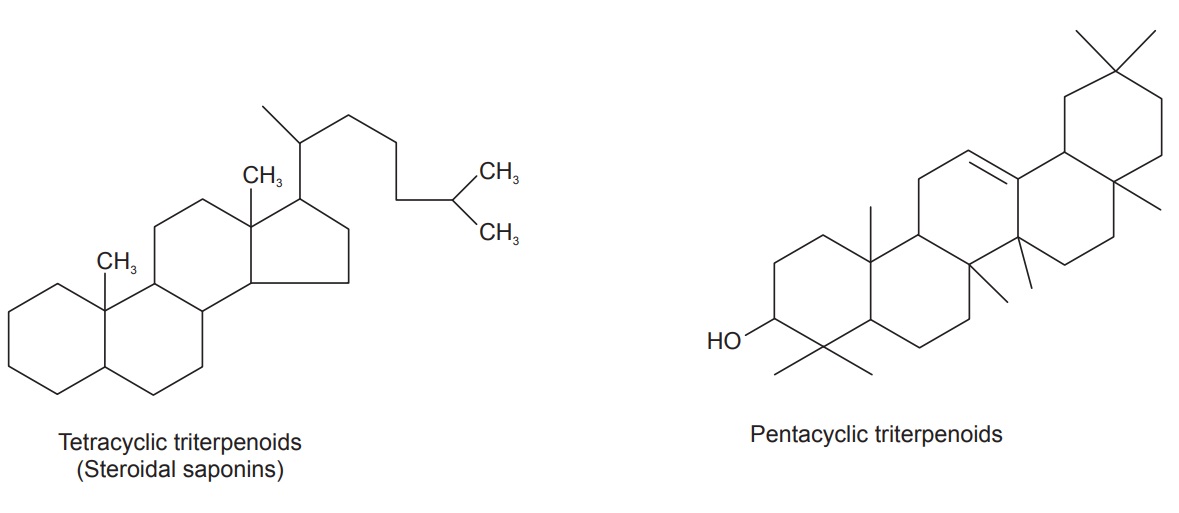Saponin Glycosides
| Home | | Pharmacognosy |Chapter: Pharmacognosy and Phytochemistry : Drugs Containing Glycosides
Saponins are glycoside compounds often referred to as a ‘natural detergent’ because of their foamy texture. They get their name from the soap wort plant (Saponaria), the root of which was used historically as a soap (Latin sapo— soap).
SAPONIN GLYCOSIDES
Saponins are glycoside compounds often referred to as a
‘natural detergent’ because of their foamy texture. They get their name from
the soap wort plant (Saponaria), the root of which was used historically as a
soap (Latin sapo— soap). Foremost
among this is the strong tendency to froth formation when shaken with water.
The other properties are hemolytic activity, sneezing effect, toxicity, complex
formation with cholesterol and antibiotic properties.
Saponins have long been known to have strong biologi-cal
activity. When studying the effect that saponins have on plants, it has been
discovered that saponins are the plants active immune system. They are found in
many plants, they consist of a polycyclic aglycone that is either a choline
steroid or tritetpenoid attached via C3 and an ether bond to a sugar
side chain. The aglycone is referred to as the sapogenin and steroid saponins
are called sarsaponins. The ability of a saponin to foam is caused by the
combination of the nonpolar sapogenin and the water soluble side chain.
Saponins are bitter and reduce the palatability of livestock
feeds. However if they have a triterpenoid aglycone they may instead have a
licorice taste as glucuronic acid replaces sugar in triterpenoids. Some
saponins reduce the feed intake and growth rate of nonruminant animals while
others are not very harmful. For example, the saponins found in oats and
spinach increase and accelerate the body’s ability to absorb calcium and
silicon, thus assisting in digestion. As mentioned earlier they are composed of
a steroid (C-27) or triterpenoid (C-30) saponin nucleus with one or more
carbohydrate branches.
Steroid Saponins
Steroid saponins are similar to the sapogenins and related
to the cardiac glycosides. They have ability to interact medically and
beneficially with the cardiac glycosides, sex hormones, Vitamin D and other
factors, render these phytochemicals components of great medical significance.
Diosgenin is the important steroid sapogenin. Recently from these saponins
steroid hormones like progesterone, cortisone etc. are obtained by partial
synthesis and thus their importance has increased considerably. Some of the
families with steroidal saponins are Solanaceae, Apocynaceae, Liliaceae,
Leguminosae, etc.

Triterpenenoid Saponins
Triterpenoid saponins, or sapogenins, are plant glycosides
which lather in water and are used in detergents, or as foaming agents or
emulsifiers, and have enormous medical implications due to their antifungal,
antimicrobial, and adaptogenic properties. Triterpene saponins are usually β-amyrine derivatives and some are also α-amyrine and lupeol derivatives. It has a
pentacyclic triterpenoid nucleus which is linked with either sugar or uronic
acid. Glycyr-rhizin, from licorice root, is an example of a saponin used for
antiinflammatory purposes in place of cortisone.
They are commonly available in dicot plants belonging to the
family Rubiaceae, Compositae, Rutaceae, Umbel-liferae, etc.
Saponins are rarely crystalline and generally amorphous
powder with high molecular weight. They carry many asymmetric centres and are
optically active. They are generally soluble in water and form colloidal
solutions. These are also soluble in ethyl and methyl alcohol and are usually
insoluble in organic solvents like petroleum ether, chloroform and acetone etc.
They are bitter in taste and nonalkaline in nature, produce sneezing and have
the property of lowering surface tension. They are hydrolysed by acids,
alkalies to yield aglycone called sapogenin and one or more molecule of same or
different sugars or their oxidation products. They can also be hydrolysed by
enzymes, soil bacteria, and by photolysis. In mild conditions using very dilute
acids (0.01–0.1 N), organic acids give rise to partially hydrolysed saponins
called prosapogenin.
Saponins are extremely toxic to fishes but do not render
them inedible, as saponins are not poisonous to man when taken orally. Very
dilute solution of saponins hemolyses red blood corpuscles. The hemolysis take
place due to the formation of complex with the cholesterol of erythrocyte
membrane causing its destruction, this is a chief property of saponin, very
rarely shown by any other plants product. Saponins accelerate the germination
and growth of the seeds. Saponins show fungicidal, bactericidal activity,
antiviral activity, antibiotic property, inflammation inhibition activity,
spermicidal, antifertility, molluscicidal, etc. Saponins have been reported to
possess blood purifying and abortion causing properties, anthelmintic effect,
sedative property and antispasmodic effects.
Saponins find wide occurrence in plant kingdom. In a
systematic study, 672 triterpenic and 125 steroidal saponins were found in 1730
species belonging to 104 families. In the whole 75% of the families showed the
presence of saponins. The wide occurrence and its comparatively higher contents
(0.1–30%) in plants, the saponins can be regarded as the most occurring plant
materials. Saponins from the different parts of the same plants have found to
possess different properties. Saponins may be distributed throughout the plant;
their content is affected by variety and stage of growth. Their function in the
plant is as storage in form of carbohydrate in the plant and act as immune
system of the plant. Saponins have also been identified in the animal kingdom in
snake venom, starfish and sea cucumber etc.
Related Topics
